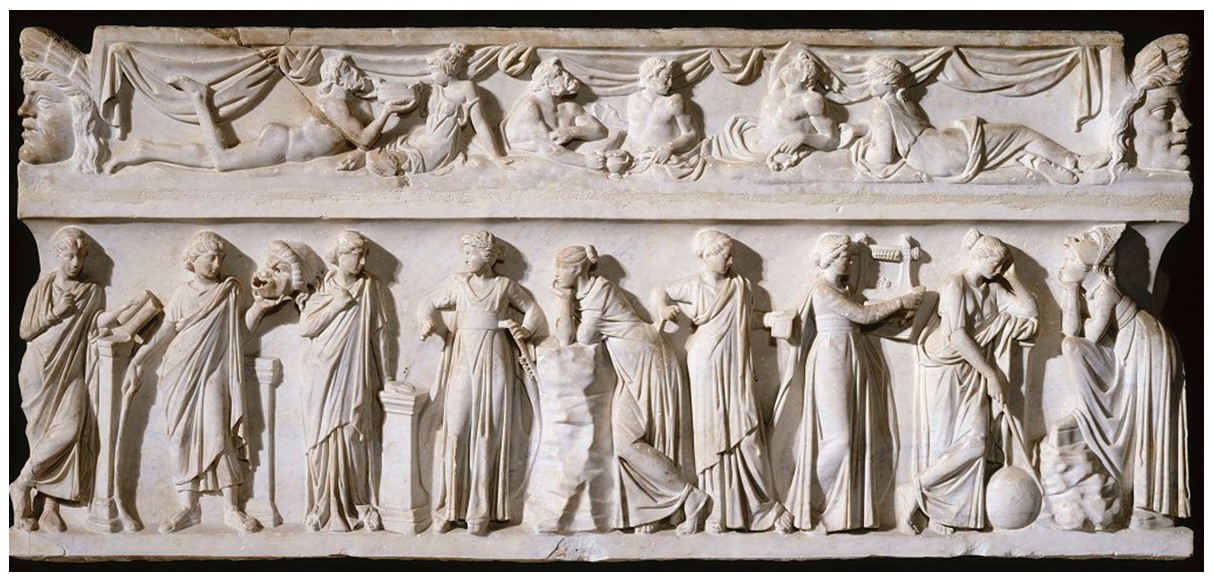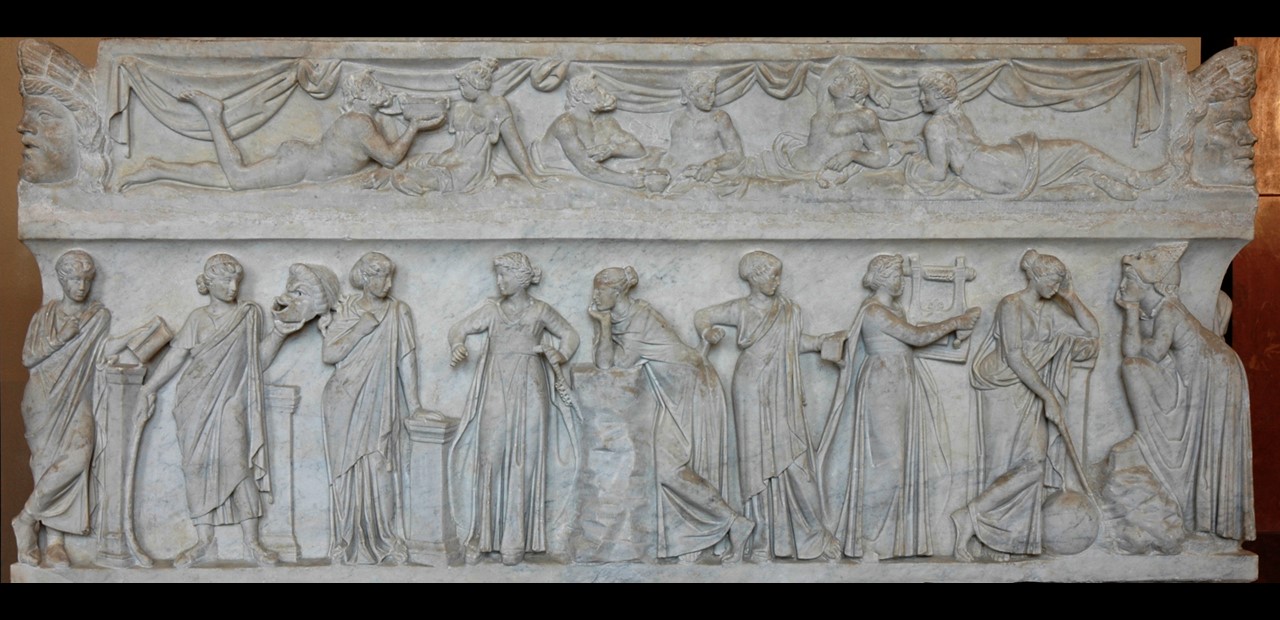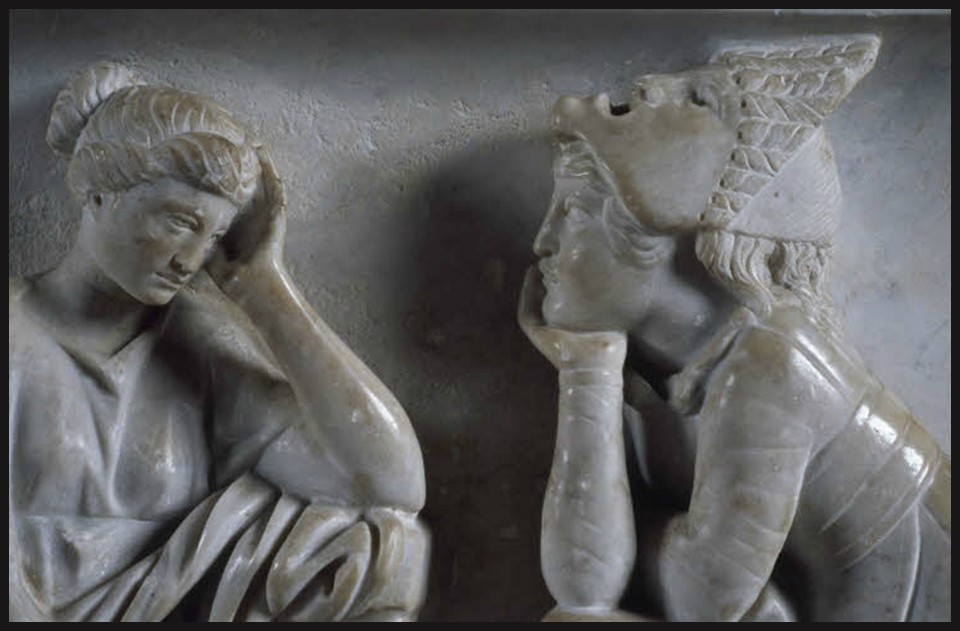
https://twitter.com/MuseeLouvre/status/1254455247449317379/photo/1
[36] Come thou, let us begin with the Muses who gladden the great spirit of their father Zeus in Olympus with their songs, telling of things that are and that shall be and that were aforetime with consenting voice. Unwearying flows the sweet sound from their lips, and the house of their father Zeus the loud-thunderer is glad at the lily-like voice of the goddesses as it spread abroad, and the peaks of snowy Olympus resound, and the homes of the immortals. And they uttering their immortal voice, celebrate in song first of all the reverend race of the gods from the beginning, those whom Earth and wide Heaven begot, and the gods sprung of these, givers of good things. Then, next, the goddesses sing of Zeus, the father of gods and men, as they begin and end their strain, how much he is the most excellent among the gods and supreme in power. And again, they chant the race of men and strong giants, and gladden the heart of Zeus within Olympus, — the Olympian Muses, daughters of Zeus the aegis-holder… Writes Hesiod in his Theogony, describing the Muses… the lovely goddesses who dance and sing and inspire poets like Homer, Virgil, Dante, John Milton, and William Blake… Can The Sarcophagus of the Muses in the Louvre help us learn more about them? https://www.theoi.com/Text/HesiodTheogony.html
It does, indeed! According to the Louvre experts… Created around the mid-second century BC, this sarcophagus was probably made for a cultivated Roman anxious to demonstrate his attachment to Greek culture, with models drawn from Greek art. The composition of the frieze, the neutral background and the retrained attitude of the Muses all evoke the classical art of the fifth and fourth centuries BCE. This impression is sustained by the very discreet employment of the drill and the rounded forms of the carefully polished surfaces. The elongated figures of the young women and their almost statuesque appearance, suggested by the depth of the relief, also recall Hellenistic art. Furthermore, each Muse is clearly identified by her attributes and demeanour… https://collections.louvre.fr/en/ark:/53355/cl010278285

https://commons.wikimedia.org/wiki/File:Muses_sarcophagus_Louvre_MR880.jpg
Let’s Identify them, starting from left to right…
Kalliope… According to Hesiod, Kalliope was the oldest of the nine Muses, the wisest, and the most assertive. As for the Roman poet Ovid, she was the Chief of all Muses! Orpheus was her son and poets since antiquity called upon her for inspiration! Kalliope is the Muse of Epic Poetry, Music, Song, Dance, and Eloquence. Her attribute is the Wax Tablet or the Scroll. Her name means beautiful-voiced.
Thalia… like all nine Muses, was the daughter of Zeus and Mnemosyne (Goddess of Memory) and the mother of the Corybantes, the warrior dancers who worshipped goddess Cybele with drumming and dancing. Thalia is the Muse of Comedy and Bucolic Poetry. Among her attributes are the Comic mask, an ivy wreath, and the shepherd’s staff. She is the joyous, flourishing Muse.
Terpsichore… whose name means Delight in Dancing, is fittingly considered the Muse of Dance. Interestingly she is usually, not in the case of the Louvre Sarcophagus, depicted sitting down, holding a lyre, accompanying the dancers’ choirs with her music. Terpsichore was the mother of the dangerous Sirens, who lured sailors with their music and singing voices to shipwreck and death! Her attribute is the lyre.
Euterpe… the Giver of Delight, was, according to ancient Greek poets, the Goddess of Lyric Poetry. Along with her sisters, she entertained the Gods and Goddesses at Mount Olympus, but she also loved to wander around Mount Helicon and Mount Parnassus. Euterpe is credited as the inventor of the Aulos, an ancient Greek wind instrument, often translated as Flute or Double-Flute. The Aulos is her attribute.
Polyhymnia… Muse of the sacred Poetry, is the most serious looking of all Muses. Often depicted pensive, and meditative, like in the case of the Louvre Sarcophagus, Polyhymnia, whose name means Praise, is often covered in a veil which is her attribute as well. Diodorus Siculus wrote that Polyhymnia, because by her great (polle) praises (humnesis) she brings distinction to writers whose works have won for them immortal fame…
Clio… whose name derives from the Greek root κλέω/κλείω, meaning to make famous or to celebrate. is the Muse of History. She is often presented holding an open scroll or seated beside a chest of books, which are her attributes as well.
Erato… is the Muse of erotic poetry, and mimic imitation. Her name, etymologically, shares the same root as Eros, the god of love! Erato is usually depicted holding her attribute, the Lyre or a Kithara, and she is adorned with a wreath of myrtle and roses!

https://mobile.twitter.com/archaeologyart/status/1448317781582172165/photo/1
Urania… the heavenly Muse of Astronomy, is often depicted wearing a cloak covered in stars, looking upwards toward the sky. In the case of the Louvre Sarcophagus, Urania is portrayed as pensive, looking downwards, pointing to the celestial Globe with a staff. In Orphic Hymn 76 to the Muses Urania is beautifully described as heavenly bright.
Melpomene… is the Melodious Muse of Tragic Poetry, the Muse who celebrates with dance and song. Melpomene is often depicted with her attributes… carrying a sword or a dagger, holding the tragic mask, and wearing cothurnus boots which were worn by tragic actors.
For a PowerPoint on The Sarcophagus of the Muses in the Louvre, please… Click HERE!
Interesting information on the 9 Muses can be found… https://www.theoi.com/Ouranios/Mousai.html and https://www.thoughtco.com/the-greek-muses-119788 and https://www.greekmythology.com/Other_Gods/The_Muses/the_muses.html and https://pantheon.org/articles/m/muse.html